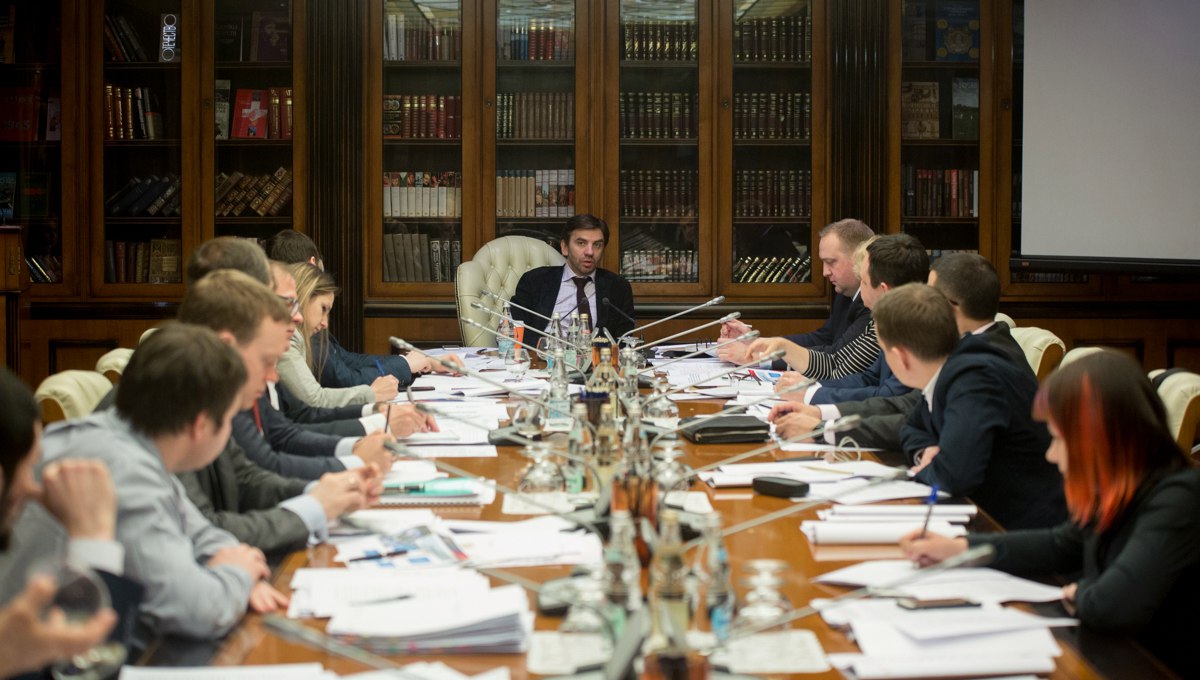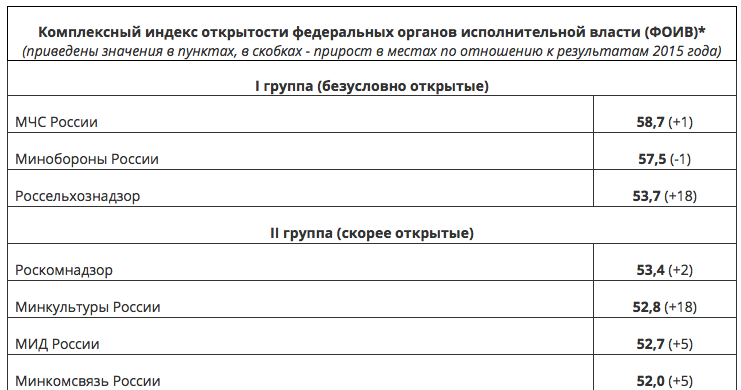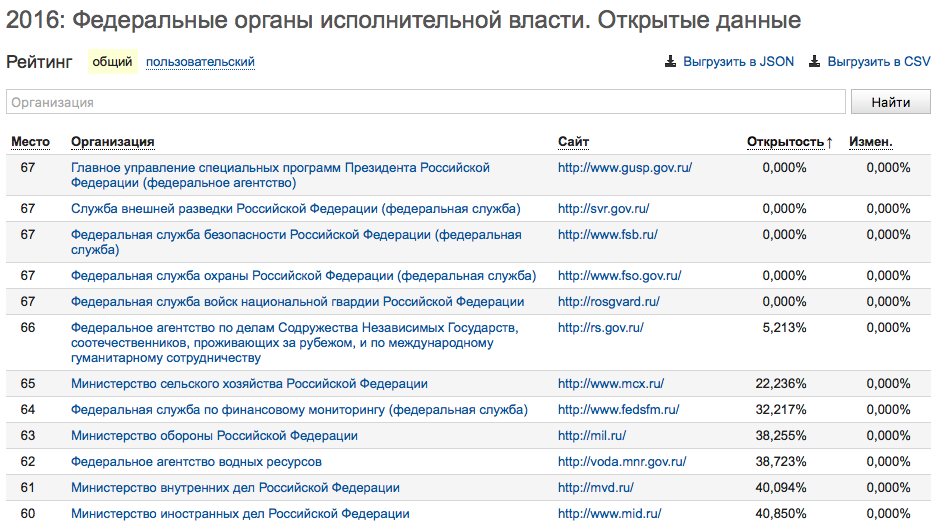Open Data Council: News from the Fields

Photo source: Open Government website
On December 23, for the first time I was lucky enough to attend a meeting of the Open Data Council . I participated on behalf of ANO Information Culture, with my participation adding the public sector to representatives of the public sector and business.
The composition of the December meeting of the council was, at first glance, impressive: representatives from the Ministry of Finance, Treasury, Rosstat, Ministry of Economic Development, Open Government, HSE, Analytical Center “Forum”, Analytical Center under the Government and Yandex gathered - as seen from the list, the non-profit sector is not enough. The agenda consisted of six voluminous items, but this did not prevent the meeting from starting half an hour later, which, however, did not surprise those who were present and was not accompanied by any comments by the organizers.
1. Elimination of duplication of statistical indicators in the Rosstat reports
')
The first item on the agenda was the Rosstat report on how to eliminate duplication of indicators in various reports and how to publish primary statistical information in open data format . The report raises many questions, starting with the method of presenting the material, which consisted in literally reading the text from handouts. From the informative memorable two points:
The first thesis was that “duplication of indicators creates an unjustified burden on business and budgets of all levels,” which implies multiple preparation and delivery of the same indicators. I was surprised by the comment of the Minister of the Open Government, Mikhail Abyzov, who said bluntly that hundreds of thousands of officials at workplaces do nothing but find figures in form from excel-tables that their managers suddenly needed. As for Rosstat, in my opinion, it is much more interesting that the pressure on budgets is created by the agency itself when it sells the collected data to regional and municipal government agencies. That is, the work of Rosstat is paid not only by our taxes, but the results of this work are sold within the state, and regional and municipal funds are used for this. But the option of reducing the burden on budgets by canceling the sale of data was not voiced.

The contract for the purchase of indicators of statistical reporting by the Administration of the Governor of the Perm Territory from the territorial body of FSSS. Source: State Cost Project
The second thesis is the work of Rosstat with big data . From the voiced text I did not get the impression that the representatives of Rosstat understand this area and terminology correctly, since in their opinion, big data is something separate from all other data and, naturally, requires additional funding. For example, Rosstat proposes “creating a single interdepartmental coordinating center for using Big Data in official statistics”, “providing Rosstat with a unified methodological control (supervision) of using Big Data in official statistics”, “developing and adopting a set of legislative and regulatory acts that ensure establishing the use of Big Data in official statistics. ” I suspect that Rosstat already has “Big Data”, however, they don’t know about it.
Although according to Rosstat, judging by my experience, the main problem today is that the data are not provided in the format of open data. Municipal statistics in the form of datasets cannot be downloaded, arrays that are uploaded to the federal portal are highly fragmented (due to which their number increases, which is so important for ratings), and statistical collections, consisting mainly of tables, are published in doc format and are printed. , and not for working with data.
2. Discussion of Treasury portals
After Rosstat, the Treasury "reported". Their report can be called an exemplary performance of a state body - a colorful presentation with the necessary explanatory phrases, competent speech, understandable and interesting content. Resources were presented bus.gov.ru and budget.gov.ru , as well as orders, on the basis of which state bodies, state and municipal institutions should publish information about themselves. Interestingly, 20 minutes at the meeting there was a discussion about whether to change one of the orders of the Ministry of Finance of Russia and add coordinates of the actual location of the institution to the list of required data or still use the Yandex / Google API to generate coordinates. Thanks to the argument of the head of the IT department of the Ministry of Finance of Russia, Elena Chernyakova, hundreds of thousands of municipal institutions will not wonder what their coordinates are and where to find them. However, it was not surprising, because interesting and adequate presentations and answers to E. Chernyakova's questions - this is what I am waiting for at each event.

Portal bus.gov.ru to post data on public institutions
Although also, as with Rosstat, in the process of working with the Treasury portals in question, we revealed much more significant problems than those discussed at the council:
- On the portal bus.gov.ru, the financial statements are incorrectly converted to a structured format : the data displayed on the website does not correspond to what is indicated in the attached originals;
- There is no documented API on the bus.gov.ru portal, and the blocking of the IP address is carried out when viewing data from only 50 institutions , that is, it is useless to upload and discuss new data, if even what is there, download / use is almost impossible;
- The portal budget.gov.ru contains many bugs in data constructors , for example, the choice of items is lost when the filter is moved to the "Indicators" section or doubled income / expense amounts are displayed if you check the "select all" option in the "Budget Level" filter;
- It is important to clarify whether the data entered by representatives of state institutions on bus.gov.ru is somehow verified : we know a long time about how representatives of government customers form data on government contracts, but have recently identified errors in financial statements, but “corrects “Their Treasury is already a few months old.
Interestingly, when discussing the geolocation of institutions, Mikhail Abyzov raised the question of whether institutions (schools) could be made to publish all the data on the USE - now we know which of the civil servants maintains openness of educational data and with whom it is worth communicating to “Russian schools” .
In this agenda item, Elena Chernyakova from the Ministry of Finance of Russia revealed the secret of numerous errors in the Incorporation data, which Tatiana Nesterenko told about at the Moscow Financial Forum in September (it took half a year, 600 million rubles and 200,000 man hours) to correct the Incorporation data. . The problem is that the submission of data to the Unified State Register of Legal Entities is declarative, therefore, for example, it is almost impossible to verify the actual address provided by the individual entrepreneur. Therefore, when the Ministry of Finance of Russia started updating its information systems, 80% of state and municipal institutions went to edit their data in the Register.
3. Proposals of the Analytical Center under the Government on the publication of these state corporations and public joint-stock companies
The third point of the Analytical Center under the Government of the Russian Federation presented the report “On Improving the Work of State Corporations and Public Joint Stock Companies with Open Data”. The main idea was to obligate these organizations to publish in machine-readable formats the information that they are already obliged to disclose (general information about the organization, vacancies, information about environmental protection, etc.). One of the participants in the meeting rightly remarked that then we would get a million datasets in different formats on different sites, and it is much more logical to publish the open part of the Register and other data collected by the Rosstat or Rosprirodnzdor from the same institutions. The comment on the USRLE was one of the most valuable comments on the board, since we have been talking about this to the FTS for a long time, but, unfortunately, this comment is not in the draft protocol.
4. Open Data Summit and Open Government Contest
The fourth item was a discussion of the summit postponed to February and the competition for open data . It is unlikely that something can be told about this point before summing up the competition, but this does not apply to statistics from the previous competition. It was announced that a large number of projects submitted to the last competition (or 50 projects, or 50%), continue to develop. I would like to look at this list, because usually a year after a contest or hackathon almost all projects become unavailable or abandoned.
5. On the work of federal executive bodies according to open data in 2016
The fifth item was postponed for February, summarizing the work of public authorities on disclosing information in the form of open data. It is noteworthy that in the materials for the meeting, far from financial state bodies (the Treasury, the Ministry of Finance of Russia, the Federal Tax Service), whose work in the field of openness is not in doubt, but, at first glance, selected at random, are indicated as leaders among the federal executive bodies. Perhaps this list is based on a rating recently prepared by the Open Government and VTsIOM .

“Certainly open ministries” according to the results of the Open Government rating and VCIOM

"Outsiders" rating of the Project Center "Infometr"
In contrast to the transparent, comprehensible and law-based Infometer rating, the VTsIOM and OP ratings raise many questions. First, it takes as a basis the number of datasets, while the Rosstat, the purpose of which is to collect data, is estimated on a par with other departments. Secondly, a significant component of the final assessment is the “demand for” sets, which is defined as the number of downloads from the federal data.gov.ru portal. Specially before the council I looked at the TOP-7 federal agencies by the number of datasets on this portal. The total number of downloads for the entire lifetime of the “leading” departments is approximately 100-150 times (this is the total number of downloads of all datasets of one department), that is, instead of judging the needlessness of the sets, you need to judge the needlessness of this portal. Thirdly, this rating evaluates only the data posted on the federal portal, without taking into account the activity of departments on their websites, due to which government agencies are forced to duplicate their data on the federal portal (and sometimes manually).

statistics of the number of downloads from the data.gov.ru portal of the Dataset of Rostourism (154), Rosavtodor (70) and the Ministry of Industry and Trade of Russia (61). By the number of datasets among FOIV they are on the 3rd, 2nd and 4th place.
Summing up ...
The sixth paragraph about the scheme of interaction between the Ministry of Communications and Mass Media of Russia with the Open Data Council was not read and was not discussed (and my patience while reading the materials ended earlier).
In general, the advice evokes a dual impression: something was adequate and interesting: for example, the Treasury report and some comments; also pleased the participation of competent people in the event. Something, on the other hand, was too formal and reminiscent of “obligatory”, in some way there was a misunderstanding of either the work with the data, or the specifics of open or big data. Very little time is devoted to discussing the reports directly - some unplanned comments on the agenda are difficult to insert, and, of course, the discussion of open data in a closed mode looks rather strange. Let's see what will happen next.
Source: https://habr.com/ru/post/318596/
All Articles